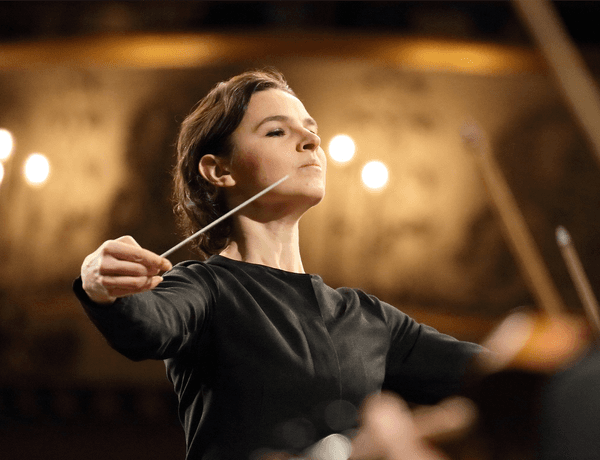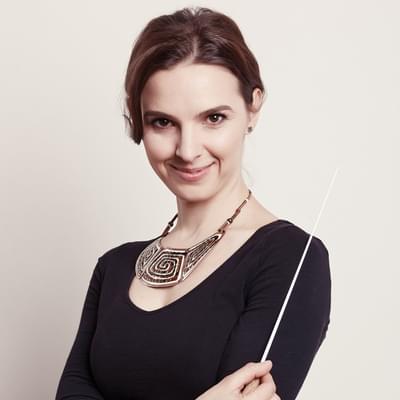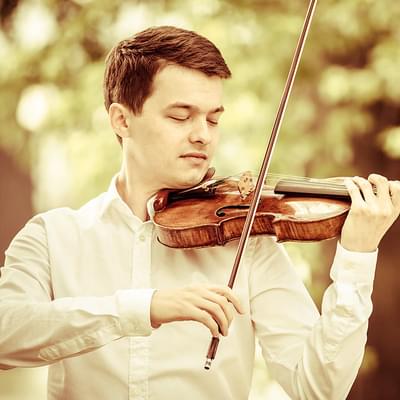Old World Symphony

Full programme
- Frolyak, Adagio (15mins)
- Tchaikovsky, Violin Concerto (33mins)
- Dvořák, Symphony No.7 (35mins)
Performers

Oksana Lyniv
Conductor
Andrii Murza
Violin
Introduction
We live in times of political challenges and war conflicts, and naturally, these upheavals also affect the world of art. For the past three years, there has been a significant debate on how culture should respond to such global events. This includes the music of the genius Tchaikovsky.
His figure illustrates how easily art can be instrumentalised. His music is currently banned from being performed in Ukraine, with the justification that Putin's bloody regime uses Tchaikovsky's music to veil its horrific war crimes. For instance, the Russians organised a symphonic concert on the ruins of a theatre in occupied Mariupol and performed Tchaikovsky's 4th Symphony there. However, this instrumentalisation is profoundly unjust because, paradoxically, during his lifetime, Tchaikovsky's work was sharply criticised in Russia for its lack of national Russian sentiment, insufficient use of Russian themes and ideas, and general orientation toward European musical styles.
Tchaikovsky was deeply interested in European cultural heritage, travelled extensively, and, by his own admission, always found a creative oasis in Ukraine. He spent several months each year in different regions of modern Ukraine, where he wrote over 30 works, predominantly featuring Ukrainian themes. Despite all his travels, he remained deeply attached to his favourite places in Ukraine. The 19th century was tragic for Ukrainians as they lacked independence, which hindered the development of professional musical life. Yet through Tchaikovsky's works, the Ukrainian influence in history of arts can be recognised.
Bohdana Frolyak's piece in the programme symbolises for me a connection with present-day Ukraine and an artistic reflection on tragic events. As the composer herself writes, the more terrifying life becomes and the darker the times, the more light she wants to embed in her music. For her, music is an unwavering belief in the triumph of good.
Regarding Dvořák, I want to highlight once again the symbolic fate - when political changes in Germany led to a decline in the performance of his works, his success in England was crucial for the further development of his creative path. In London, Dvořák received considerable support, and there he was honoured with membership in the London Philharmonic Society. He achieved worldwide success, but always remained attached to his homeland. In this, he is very close to me.
Programme Notes
Dark passions from the soul of Eastern Europe. Dvořák saw a train roaring into a station and heard the melody that would grow into his Seventh Symphony. Tchaikovsky poured his heart into a Violin Concerto that dances as well as sings (and soloist Andrii Murza can do both). As for Bohdana Frolyak: well, her Adagio just speaks straight to the heart. Her fellow-Ukrainian Oksana Lyniv brings the same commitment to every note she conducts.
Adagio in Memory of Myroslav Skoryk
Bohdana Frolyak (b.1968)
Even dark times can yield light, and a rare positive outcome of recent political events has been a renewed interest in the art and culture of Ukraine – a nation long consigned by the West to the memory-hole of the Soviet bloc, but which in truth (as we’re belatedly rediscovering) has always seen itself at the heart of Europe.
Bohdana Frolyak was born in 1968 (the year of the Prague Spring) in Vidyniv in western Ukraine: a region where Polish, Ruthenian, Romanian and Jewish cultures mingled and thrived until 1918 as part of the German-speaking Austro-Hungarian monarchy. She trained in Lviv; formerly Lemberg: a city which historically took its cultural cues from Vienna rather than Kyiv, and where – after a stint in Krakow – she teaches to this day.
Frolyak composed her Adagio in Memory of Myroslav Skoryk in 2021 as a personal tribute to her late teacher, one of the most admired Ukrainian composers of his generation. Skoryk (1938-2020) was born in Lviv to Viennese parents but grew up in Siberia, where his family had been deported by Stalin. It isn’t strictly true to say that Frolyak’s homage looks both East and West, but over the course of this heartfelt, intensely emotional symphonic slow movement for full orchestra there are certainly episodes of threat and shadow – though the legacy of Mahler makes its presence felt very soon after the opening. The mood is loving, as well as melancholy; and in the final bars, harp and vibraphone delicately hint at one of Skoryk’s own best-loved melodies. We don’t have to recognise the tune to feel the sincerity and compassion of Frolyak’s response to a life well-lived, and deeply missed.
Violin Concerto
Piotr Ilyich Tchaikovsky (1840-1893)
in D, Op.35
I. Allegro moderato
II. Canzonetta: Andante
III. Allegro vivacissimo
Tchaikovsky married on 18th July 1877 and realised instantly that he’d made a terrible mistake. In early October he suffered a devastating nervous breakdown, and his brother Modest escorted him away from Russia (and the mushrooming scandal) to begin a long recuperation in the West. The process wasn’t easy; they travelled through Rome, Venice, Paris and Vienna without finding the peace that Piotr needed. Only drink seemed to help, and attempts to compose – mostly piano miniatures –
were painful.
But in March 1878 Tchaikovsky moved into a lakeside villa at Clarens, near Geneva, and five days later was joined by Iosif Kotek, a violinist friend from Moscow. Perhaps it was the change of scene, the arrival of spring, or the arrival of Kotek, but by 17th March he’d begun work on a violin concerto, and by 28th March the first draft was complete.
After the bleak months that had come before it, and the pain and sadness of the music that came directly from them, the Violin Concerto was like a release – a sudden, grateful outpouring of sunshine, warmth and affection. Completed on 11th April 1878, it was premiered in Vienna in December 1881 and has never left the repertoire since. The concerto opens with a graceful orchestral introduction and then opens out to let the solo instrument sing. Despite the swaggering trumpets that crown the first movement’s climaxes and a long, brilliant unaccompanied cadenza, it’s music from a peaceful and sunlit landscape.
But that’s not the whole story. “Mountains are very fine, but it’s difficult for a Russian to stand them for long” Tchaikovsky wrote “I’m dying for a plain, for a boundless distant prospect”. And in his Canzonetta, he distils his homesickness into a pure, expressive, and very Russian longing. The release, when it comes, is doubly joyous – a finale that’s both a flamboyant virtuoso showpiece, and an exuberant celebration of Russian folkdance. He was ready to come home.
Symphony No.7
Antonín Dvořák (1841-1904)
in D minor, Op.70
I. Allegro maestoso
II. Poco adagio
III. Scherzo: Vivace
IV. Finale: Allegro
Antonín Dvořák was a proud Czech, but he was also a musician in the great Austro-German symphonic tradition. His gifts were spotted by Johannes Brahms, and thanks to Brahms’s endorsement, publishers and conductors gradually started to recognise him as more than just a creator of colourful folk rhapsodies and Slavonic Dances – in fact, as an original and powerful musical thinker in the European mainstream. By the early 1880s his urge to assert these credentials was becoming a pressing personal need. A commission from Vienna prompted his Symphony No.6 (1881), which paid explicit homage to Beethoven, Schumann and Brahms. Dvořák spoke with a Czech accent, but his message was international.
Dvořák’s Seventh Symphony was commissioned by the London Philharmonic Society, and premiered under Dvořák’s own baton in St James’s Hall, London on 22nd April 1885 - to huge acclaim. He was delighted: “I am convinced that England offers me a new and certainly happier future…the English are a fine people, enthusiastic about music”. His self-discipline was ruthless; even after that first performance, he cut forty bars from the slow movement. “Now I am convinced that there is not a superfluous bar in the work”, he told his publisher Simrock.
And yet the roots of the symphony were as personal, and as spontaneous, as anything in Dvořák’s career. Dvořák was a lifelong railway enthusiast, and in early December 1884, while making his daily visit to Prague’s Franz Joseph Station, he witnessed the arrival of a special train bringing Czech patriots from Hungary to a nationalist gala concert. As the train pulled to a halt, he recalled, “the first subject of my new symphony flashed into my mind”.
Days later, he was hard at work: “I am now busy with this symphony for London”, he told a friend, three days before Christmas “which must be such as to make a stir in the world, and God grant that it may!” What’s particularly significant about this theme is that it doesn’t evoke a railway rhythm, or a Czech national hymn. It’s dark, taut and poised – a premonition of great events, rather than a depiction of them, and perfect material for a tense, stormy first movement, whose lovely, swaying second melody (introduced by a poignant oboe) intensifies, rather than diminishes its sombre tragic power.
Early in the new year, he completed the Poco adagio, and scribbled on the score the footnote “From the sad years”. Dvořák was an affectionate and devoted father, and the deaths in 1878 of both his 11-month old daughter Růžena and his three-year old son Otakar continued to haunt him.
In this glorious slow movement, that emotion is initially recollected in tranquility; though the soft woodwind hymn with which it opens first blossoms (flowing strings and a caroling horn), then builds to an impassioned and trumpet-torn climax before sinking gently into the evening calm.
The lilting Scherzo is so infectious that it hardly needs comment; part bittersweet waltz, part stamping Czech Furiant – and all Dvořák. His beloved pet pigeons get a look-in at the beginning of the pastoral central Trio section. But this is a symphony “to make a stir in the world”, after all; serious matters are at stake and storm-clouds gather once more at the opening of the finale, while that gentle birdsong becomes a warning cry on the clarinet.
Once again, a lighter second theme (sung by cellos over a cheerful polka rhythm) simply intensifies the drama around it. Turbulent, powerful and relentless, Dvořák sees his tragic symphony through to the bitter end. And as blazing trombone chords finally break through the darkening skies of the closing bars, it’s possible that Dvořák never brought any of his symphonies to a more powerful finish.
© Richard Bratby
Featured image © Wilfried Hösl